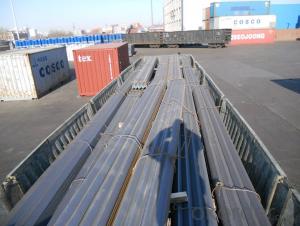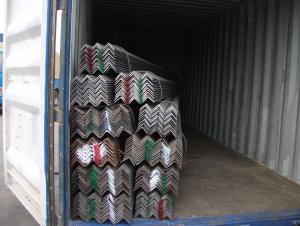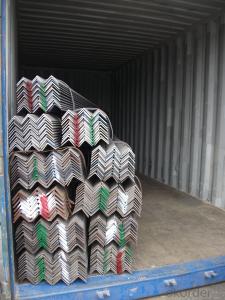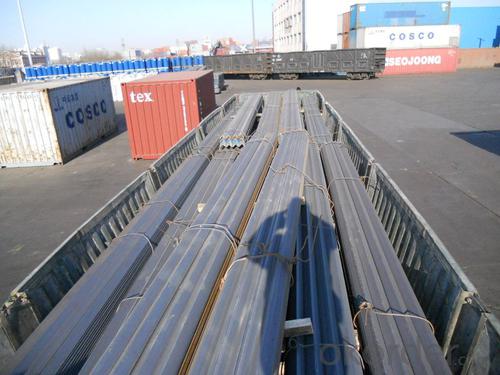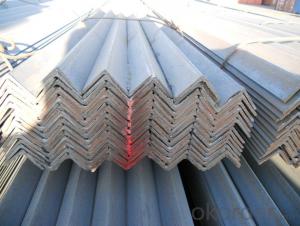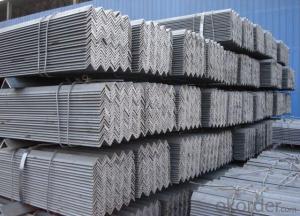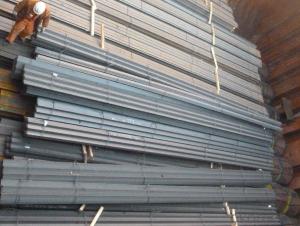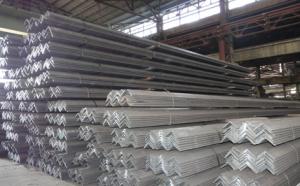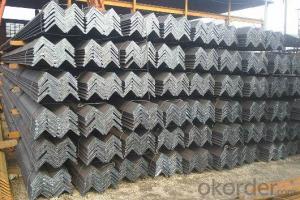Structure Steel Hot Rolled Angle Bar
- Loading Port:
- China Main Port
- Payment Terms:
- TT or LC
- Min Order Qty:
- -
- Supply Capability:
- -
OKorder Service Pledge
OKorder Financial Service
You Might Also Like
Product Description:
OKorder is offering Structure Steel Hot Rolled Angle Bar at great prices with worldwide shipping. Our supplier is a world-class manufacturer of steel, with our products utilized the world over. OKorder annually supplies products to European, North American and Asian markets. We provide quotations within 24 hours of receiving an inquiry and guarantee competitive prices.
Product Applications:
Trusses;
Transmission towers;
Telecommunication towers;
Bracing for general structures;
Stiffeners in structural use.
Product Advantages:
OKorder's Structure Steel Hot Rolled Angle Bar are durable, strong, and resist corrosion.
Main Product Features:
· Premium quality
· Prompt delivery & seaworthy packing (30 days after receiving deposit)
· Corrosion resistance
· Can be recycled and reused
· Mill test certification
· Professional Service
· Competitive pricing
Product Specifications:
1.Standards:GB,ASTM,BS,AISI,DIN,JIS
2.Invoicing on theoretical weight or actual weight as customer request
3.Material: JIS G3192,SS400;SS540.
4. Payment terms:
1).100% irrevocable L/C at sight.
2).30% T/T prepaid and the balance against the copy of B/L.
3).30% T/T prepaid and the balance against L/C
5.Sizes:
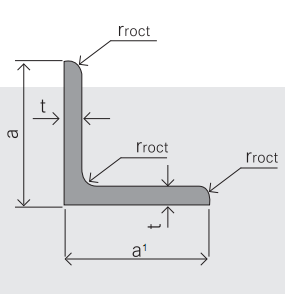
EQUAL ANGLES SIZES |
| ||
a(mm) | a1(mm) | thickness(mm) | length |
25 | 25 | 2.5---3.0 | 6M/12M |
30 | 30 | 2.5---4.0 | 6M/12M |
38 | 38 | 2.5 | 6M/12M |
38 | 38 | 3.0---5.0 | 6M/12M |
40 | 40 | 3.0---6.0 | 6M/12M |
50 | 50 | 3 | 6M/12M |
50 | 50 | 3.7---6.0 | 6M/9M/12M |
60 | 60 | 5.0---6.0 | 6M/9M/12M |
63 | 63 | 6.0---8.0 | 6M/9M/12M |
65 | 65 | 5.0---8.0 | 6M/9M/12M |
70 | 70 | 6.0---7.0 | 6M/9M/12M |
75 | 75 | 5.0---10.0 | 6M/9M/12M |
80 | 80 | 6.0---10.0 | 6M/9M/12M |
90 | 90 | 6.0---10.0 | 6M/9M/12M |
100 | 100 | 6.0---12.0 | 6M/9M/12M |
120 | 120 | 8.0-12.0 | 6M/9M/12M |
125 | 125 | 8.0---12.0 | 6M/9M/12M |
130 | 130 | 9.0-12.0 | 6M/9M/12M |
140 | 140 | 10.0-16.0 | 6M/9M/12M |
150 | 150 | 10---15 | 6M/9M/12M |
160 | 160 | 10---16 | 6M/9M/12M |
180 | 180 | 12---18 | 6M/9M/12M |
200 | 200 | 14---20 | 6M/9M/12M |
Packaging & Delivery of Angle Steel
1. Transportation: the goods are delivered by truck from mill to loading port, the maximum quantity can be loaded is around 40MTs by each truck. If the order quantity cannot reach the full truck loaded, the transportation cost per ton will be little higher than full load.
2. With bundles and load in 20 feet/40 feet container, or by bulk cargo, also we could do as customer's request.
3. Marks:
Color mark: There will be color marking on both end of the bundle for the cargo delivered by bulk vessel. That makes it easily to distinguish at the destination port.
Tag mark: There will be tag mark tied up on the bundles. The information usually including supplier logo and name, product name, made in China, shipping marks and other information request by the customer.
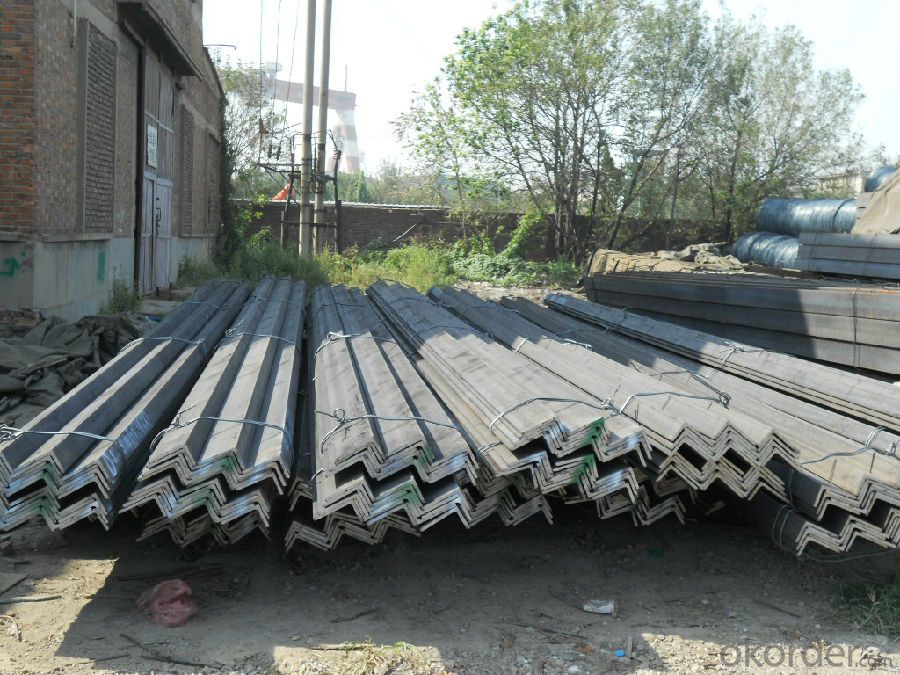
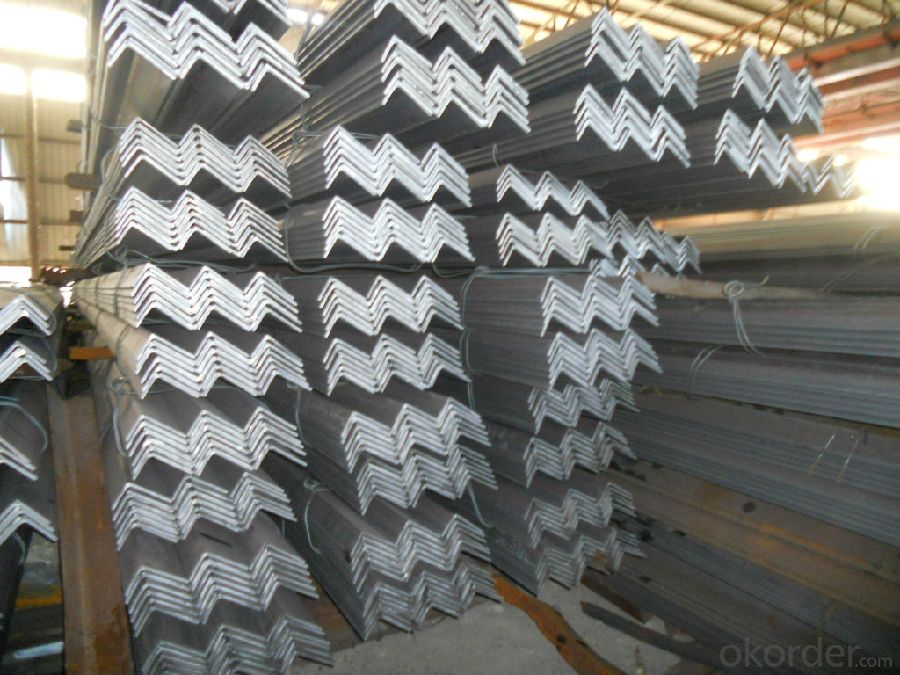
FAQ:
Q1: Why buy Materials & Equipment from OKorder.com?
A1: All products offered byOKorder.com are carefully selected from China's most reliable manufacturing enterprises. Through its ISO certifications, OKorder.com adheres to the highest standards and a commitment to supply chain safety and customer satisfaction.
Q2: How do we guarantee the quality of our products?
A2: We have established an advanced quality management system which conducts strict quality tests at every step, from raw materials to the final product. At the same time, we provide extensive follow-up service assurances as required.
Q3: How soon can we receive the product after purchase?
A3: Within three days of placing an order, we will begin production. The specific shipping date is dependent upon international and government factors, but is typically 7 to 10 workdays.
- Q: Can steel angles be used in sign support structures?
- Absolutely! Sign support structures can definitely utilize steel angles. These angles are widely employed in construction owing to their remarkable robustness and endurance. They offer exceptional support and stability, rendering them ideal for various applications, including sign support structures. By welding or bolting steel angles together, a strong framework can be effortlessly created for sign mounting. Furthermore, their exceptional load-bearing capacity is crucial in guaranteeing the sign's security and stability, particularly during unfavorable weather conditions. Moreover, steel angles can be tailored to meet specific design specifications, making them a versatile option for sign support structures.
- Q: Are steel angles available in different grades?
- Different grades of steel angles are indeed available. Carbon steel is the commonly used material for steel angles, and it comes in various grades like A36, A572, and A588. These grades possess distinct chemical compositions and mechanical properties, rendering them suitable for diverse applications. Furthermore, stainless steel angles are also obtainable in grades such as 304 and 316, which exhibit exceptional corrosion resistance characteristics. Selecting the appropriate grade of steel angle depends on specific project requirements, encompassing strength, longevity, and resistance to corrosion.
- Q: What are the common grades of steel used for angles?
- The specific application and requirements determine the various common grades of steel used for angles. Amongst these, A36, A572-50, and A588 are the most frequently utilized. A36, known for its strength and versatility, is a low carbon steel commonly employed in construction and structural applications. A572-50, on the other hand, is a high-strength, low-alloy steel widely used in structural applications due to its exceptional weldability and formability. In contrast, A588, a high-strength, low-alloy steel, finds its primary use in outdoor applications like bridges and buildings, owing to its excellent corrosion resistance. These grades of steel possess distinct characteristics and properties, enabling diverse applications and ensuring adherence to specific project requirements.
- Q: How do steel angles behave under seismic forces?
- Steel angles behave differently under seismic forces depending on their design, size, and connection details. Generally, steel angles are commonly used in seismic-resistant structures due to their ability to dissipate energy and resist lateral forces. Here are some key characteristics of how steel angles behave under seismic forces: 1. Ductility: Steel angles exhibit high ductility, which allows them to undergo large deformations without failure. This property is crucial in seismic design as it allows the structure to absorb and dissipate energy during an earthquake, preventing sudden collapse. 2. Flexibility: Steel angles have the ability to flex and bend under seismic forces, allowing them to absorb energy and reduce the impact on the overall structure. This flexibility helps in distributing the seismic forces throughout the structure, minimizing localized damage. 3. Connection behavior: Proper connection design is crucial to ensure the performance of steel angles under seismic forces. The connections should be designed to allow for rotation and accommodate the expected displacements during an earthquake. Adequate connections prevent the angles from becoming brittle or failing prematurely. 4. Buckling resistance: Steel angles are susceptible to buckling under compression forces. To enhance their buckling resistance, lateral bracing or stiffeners are often used. These elements provide additional support to the angles and help prevent buckling during seismic events. 5. Strength and stiffness: Steel angles have high strength and stiffness, which allows them to resist the lateral forces induced by an earthquake. The strength of steel angles can be enhanced through proper material selection, such as using higher-grade steel with greater yield strength. Overall, steel angles are well-suited for seismic-resistant structures due to their ductility, flexibility, and strength. However, their behavior under seismic forces heavily relies on proper design, connection details, and adherence to seismic codes and standards. It is essential to consult with structural engineers and follow best practices to ensure the optimal performance of steel angles in seismic design.
- Q: How are steel angles installed or fixed in place?
- Steel angles are commonly used in construction to provide structural support and reinforcement. They are installed or fixed in place using various methods, depending on the specific application and requirements of the project. One common method of installing steel angles is by welding. This involves permanently fusing the angles to the desired location using a welding machine. Welding provides a strong and durable connection, ensuring the angles stay in place even under heavy loads or vibrations. However, welding requires skilled labor and specialized equipment. Another method is bolting. Steel angles can be bolted to the supporting structure using bolts or screws. This method allows for easy installation and removal, making it suitable for situations where adjustments or modifications may be required. Bolting also offers flexibility in terms of repositioning or replacing the angles if needed. In some cases, steel angles are attached to the structure using adhesive bonding. This method involves applying a strong adhesive material between the angle and the supporting surface. Adhesive bonding is particularly useful when welding or bolting is not feasible or desired. However, it is important to ensure that the adhesive used is suitable for the specific application and can withstand the loads and environmental conditions. Additionally, steel angles can be installed using a combination of methods. For example, welding can be used to provide the primary attachment, while bolts or adhesive bonding can be used as secondary supports or reinforcements. It is crucial to consult with structural engineers or professionals to determine the most appropriate method for installing steel angles based on the specific project requirements, load conditions, and local building codes. Proper installation ensures the angles are securely fixed in place, providing the necessary strength and stability to the structure.
- Q: How do you determine the required angle thickness for a specific application?
- Determining the required angle thickness for a specific application involves considering several factors. Firstly, it is important to understand the load or force that will be applied to the angle. This can be determined by analyzing the specific application and the expected weight or pressure that will be exerted on the angle. Secondly, the material of the angle must be taken into account. Different materials have different strength properties, and their ability to withstand the applied load will vary. It is crucial to select a material that has the required strength and durability for the specific application. Additionally, the length of the angle and the distance between its supports should be considered. Longer angles or larger distances between supports may require thicker angles to prevent buckling or bending under the applied load. Furthermore, environmental factors such as temperature, humidity, or corrosive substances may affect the required thickness of the angle. In corrosive environments, for instance, a thicker angle may be necessary to ensure its longevity and structural integrity. Lastly, any applicable building codes, regulations, or industry standards should be consulted to ensure compliance and safety. These guidelines often provide specific recommendations or requirements for angle thickness based on the intended application. In conclusion, determining the required angle thickness for a specific application requires analyzing the load, material strength, length, support distance, environmental factors, and relevant regulations. Proper consideration of these factors will help ensure the angle's ability to withstand the applied load and provide a safe and durable solution for the given application.
- Q: How do you calculate the shear force on a loaded steel angle?
- To calculate the shear force on a loaded steel angle, you need to consider the applied load, the geometry of the angle, and the material properties of the steel. The shear force refers to the force acting parallel to the cross-sectional area of the angle. First, determine the applied load that is acting on the steel angle. This could be a concentrated load, distributed load, or a combination of both. It is important to accurately determine the magnitude and location of the load. Next, consider the geometry of the steel angle. The angle has two legs, with each leg having a specific length, width, and thickness. Measure these dimensions accurately. Once you have the load and angle dimensions, you can calculate the shear force using the formula: Shear Force = Load / Cross-sectional Area To calculate the cross-sectional area, you need to consider the shape of the angle. The cross-sectional area of a steel angle is typically calculated as the sum of the areas of the two legs minus the area of the corner radius. If the angle has unequal legs, the cross-sectional area can be calculated as the sum of the areas of the longer and shorter legs minus the area of the corner radius. After calculating the cross-sectional area, divide the applied load by this value to obtain the shear force on the loaded steel angle. It is important to note that the above calculation assumes the steel angle is subjected to pure shear. In practical situations, other factors such as bending moments and torsion may also need to be considered, which would require more complex calculations and analysis. Therefore, it is advisable to consult relevant design codes, structural engineering principles, or seek the advice of a professional engineer for accurate and reliable results.
- Q: Can steel angles be used in seismic or earthquake-resistant construction?
- Yes, steel angles can be used in seismic or earthquake-resistant construction. Steel angles are commonly used in structural applications as they provide strength and stability to a structure. In seismic or earthquake-resistant construction, the primary goal is to design and construct buildings that can withstand the forces generated by an earthquake. Steel angles can be utilized in various ways to enhance the seismic resistance of a structure. One common application is to use steel angles as bracing elements. Bracing systems are employed to help distribute the seismic forces throughout the structure, reducing the possibility of collapse. Steel angles can be used as diagonal bracing members, providing additional strength and stiffness to the building. Additionally, steel angles can be used as moment-resisting frames in seismic design. Moment-resisting frames are designed to dissipate and absorb the energy generated during an earthquake. By incorporating steel angles into the frame, the structure can effectively resist the lateral forces and remain stable during seismic events. Moreover, steel angles can be employed in the construction of steel moment frames, which are widely used in seismic design. These frames consist of steel columns and beams connected by steel angles or other connections capable of resisting the forces induced by an earthquake. Steel angles play a crucial role in transferring forces between the different members of the frame, ensuring the overall stability and integrity of the structure. In conclusion, steel angles can be effectively utilized in seismic or earthquake-resistant construction. Their strong and versatile nature makes them suitable for bracing systems, moment-resisting frames, and steel moment frames, all of which contribute to enhancing the seismic resistance of a structure. However, it is crucial to ensure that the design and installation of steel angles comply with the relevant building codes and regulations to guarantee the safety and durability of the construction.
- Q: How do steel angles perform under static or stationary loading conditions?
- Steel angles perform well under static or stationary loading conditions. Due to their structural shape and high strength, they can effectively withstand and distribute loads without significant deformation or failure. Their stability and resistance to bending or buckling make them suitable for various applications in construction and engineering projects.
- Q: What is the process of cold bending steel angles?
- The process of cold bending steel angles involves using hydraulic or mechanical forces to gradually shape the steel angle into a desired curve or angle without the use of heat. This is achieved by carefully manipulating and applying pressure to the steel angle until it is bent to the desired shape.
Send your message to us
Structure Steel Hot Rolled Angle Bar
- Loading Port:
- China Main Port
- Payment Terms:
- TT or LC
- Min Order Qty:
- -
- Supply Capability:
- -
OKorder Service Pledge
OKorder Financial Service
Similar products
Hot products
Hot Searches
Related keywords
